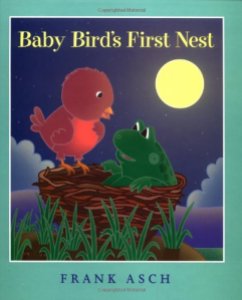Baby Bird’s First Nest–does the title run shivers up your spine? Is the author/illustrator the next Tom Clancy or James Patterson perhaps?
And therein lies the beauty of reading to a live audience. I chose Baby Bird’s First Nest because it was a sweet story with bright pictures, little realizing that it was so suspenseful.
After Baby Bird’s fall from the nest, “Darkness loomed all around her. Even the moon looked cold and scary.” Frank Asch’s text is just right for little listeners.
Baby Bird’s new friend, Frog, helps her build her very first nest. All is well until he hears . . . paws!
Many writers have their characters hear footsteps, but “paws” is particularly effective here, as is the close-up of the hungry predator’s face. And– Baby Bird can’t fly yet!
So why do we like to be scared, but not too scared? Psychologists say we like the adrenaline rush.
But there’s more than suspense in this tale of Baby Bird–there’s a powerful story of friendship as Frog lends a hand.
There’s a lesson here: see a need, give help.
In her excellent article, Teaching empathy: Evidence-based tips for fostering empathy in children, Gwen Dewar, Ph.D. notes:
Stories—from books or television—are opportunities for kids to practice perspective-taking skills. What do the characters think, believe, want, or feel? And how do we know it?
When families discuss these questions, kids may learn a lot about the way other people’s minds work (Dunn et al 2001). In one experimental study, 110 school kids (aged 7 years) were enrolled in a program of reading. Some students were randomly assigned to engage in conversations about the emotional content of the stories they read. Others were asked only to produce drawings about the stories. After two months, the kids in the conversation group showed greater advances in emotion comprehension, theory of mind, and empathy, and the positive outcomes “remained stable for 6 months” (Ornaghi et al 2014).
According to Dr. Dewar, experiments suggest that kids are more likely to feel empathy for individuals who arefamiliar and/or similar to them. Baby Bird and Frog are clearly very different, but that does not seem to matter. They are drawn together by the one’s need and the other’s kindness. Is there another lesson for us here?
Enjoy the adrenaline rush, take advantage of the mounting excitement to help children predict outcomes, immerse yourself and your young listeners in Baby Bird’s predicaments, admire Frog’s kindness and initiative–and enjoy the story!
And perhaps join me in a challenge. Can we, too, write stories that are so full of life lessons and so engaging to our listeners?


